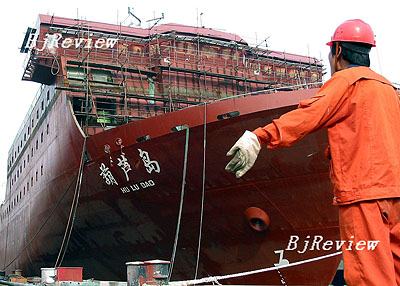
Jinzhou Bay in Liaoning Province is a fine bay on the north bank of the Bohai Sea, and Jinzhou Port is the largest of its kind in this bay. The port’s annual handling capacity stood at about 23 million tons in recent years. With such handling capacity, Jinzhou Port is considered relatively small as far as Chinese ports go. Because of this, port managers decided to expand the port by increasing its annual handling capacity to more than 100 million tons.
But just 100 km away, the port of Huludao-also located in Jinzhou Bay-has recently started large scale construction with the same aim: being a 100-million-ton port.
The two neighbors, which share the same bay, had set port development as their important economic strategies. Hence, they began to compete over a distance of less than 100 km.
With fast regional economic development, the concept of regional economies has emerged. The Yangtze River Delta, Bohai Rim Economic Circle, Beijing-Tianjin-Hebei Economic Circle, revitalization of the northeast China industrial base, western development and the rise of central China are just a few examples. Many local officials, when receiving visiting guests, often stand in front of a hanging map and describe with pride what economic circle they reside within. But within these circles you will find an interesting phenomenon: conflicts as well as cooperation. Such economic conflicts exist among not only different regional economies, but also different areas within the same regional economy.
Competition between the Jinzhou and Huludao ports in northeast China is only one small example of a regional economic conflict-such conflicts exist in many places every day.
Chen Xuanqing, Deputy Director of the Department of Regional Economy under the National Development and Reform Commission (NDRC), says that these intensifying regional economic conflicts bring into focus the problem of redundant construction within the Chinese economy.
Harming the economy
Zhang Keyun, Deputy Director of the Institute of Regional Economies and Management under the School of Public Administration of Renmin University of China, said that the present regional economic conflicts in China began as early as 2002.
According to Zhang, before China entered the WTO in December 2001, China had experienced years of inadequate internal and external demand. After China’s WTO accession, this situation began to change. In the first half of 2002, collective and private investment increased 15.8 percent and 19.4 percent respectively, contributing 23.8 percent of the country’s total fixed asset investment. All localities began to launch investment projects, and among these, iron and steel plants, raw materials such as electrolytic aluminum and cement, as well as power and coal registered the largest investment growth.
“Regional economic conflicts caused by similar conditions such as resources are very common in China,” said He Liping, professor at the Department of Economics of Beijing Normal University.
Since many adjacent localities in China have similar resources, natural conditions and infrastructure, they have similar advantages in developing the same types of companies. Therefore, different localities try their best to lure capital to develop their economies, as well as to boost the political achievements of local officials. After one locality establishes a company that can utilize local resources, neighboring localities soon follow with copycat versions.
“The most direct result of regional economic conflicts is redundant construction,” said Chen.
Since China launched reform and opening- up, it has seen three periods of redundant construction triggered by economic conflicts among different regions. The first came around 1980 with redundant production concentrated on textiles and daily commodities such as bicycles, sewing machines and wristwatches; the second appeared between 1985-88, with most redundant projects being in durables like color TVs, refrigerators and washing machines; and the third arrived after 1992, with redundant construction concentrated on heavy and chemical industries like automobiles, electronics, machinery and petrochemicals. The Chinese Government had to spend much time and money to stave off redundant construction.
| 